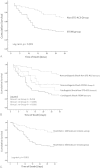The Use of Intra-aortic Balloon Pump in a Real-World Setting: A Comparison between Survivors and Nonsurvivors from Acute Coronary Syndrome Treated with IABP. The Jakarta Acute Coronary Syndrome Registry
- PMID: 24436615
- PMCID: PMC3830567
- DOI: 10.1055/s-0033-1348884
The Use of Intra-aortic Balloon Pump in a Real-World Setting: A Comparison between Survivors and Nonsurvivors from Acute Coronary Syndrome Treated with IABP. The Jakarta Acute Coronary Syndrome Registry
Abstract
Real-world data on acute coronary syndrome (ACS) patients who received intra-aortic balloon pump (IABP) support are limited. The objective of this study was to evaluate the characteristics of ACS patients who received IABP support from a real-world ACS registry. Patients with ACS (N = 121) who received IABP support were enrolled. Characteristics of survivors and nonsurvivors were compared at 30 days. Mortality rate of patients with ACS who received IABP was 47%. The survivors (N = 64) had less often cardiogenic shock (p < 0.001), more often IABP usage as back-up for a revascularization procedure (p = 0.002), less often resuscitation (p = 0.043), and less mechanical ventilator support (p < 0.001) than nonsurvivors. The nonsurvivors had a significantly higher leukocyte count (p = 0.033), a higher serum creatinine level (p < 0.001), a higher blood sugar on admission (p = 0.001), higher creatine kinase MB levels (p = 0.002), and a higher serum uric acid level (p < 0.001), but significantly lower left and right ventricular function (p = 0.014 and p = 0.003, respectively) than survivors. At 30 days, non-ST elevation (STE)-ACS patients had lower mortality rate than ST segment elevation myocardial infarction patients (log-rank test, p < 0.001), and non-STE-ACS patients who had not suffered from cardiogenic shock showed the lowest mortality rate (log-rank test, p < 0.001). By multivariate analysis, a heart rate ≥ 100 beats per minute before IABP insertion was the strongest predictor of 30-day mortality (hazard ratio = 5.69; 95% confidence interval, 1.49 to 21.78; p = 0.011). In ACS patients presenting with either cardiogenic shock, resuscitated, or patients who needed mechanical ventilation suffered from high mortality, despite the use of IABP. IABP appears to be safe and tended to be favorable in noncardiogenic shock ACS patients, particularly non-STE-ACS. A heart rate of ≥ 100 beats per minute prior to IABP insertion was the strongest predictor of 30-day mortality.
Keywords: ACS; IABP; nonsurvivor; survivor.
Conflict of interest statement
Figures

Similar articles
-
Predictors of mortality in patients with cardiogenic shock treated with primary percutaneous coronary intervention and intra-aortic balloon counterpulsation.Med Klin Intensivmed Notfmed. 2016 Nov;111(8):715-722. doi: 10.1007/s00063-015-0118-8. Epub 2015 Nov 23. Med Klin Intensivmed Notfmed. 2016. PMID: 26596273 English.
-
Impact of intra-aortic balloon pump support initiated before versus after primary percutaneous coronary intervention in patients with cardiogenic shock from acute myocardial infarction.Int J Cardiol. 2013 Oct 9;168(4):3758-63. doi: 10.1016/j.ijcard.2013.06.009. Epub 2013 Jul 3. Int J Cardiol. 2013. PMID: 23830073
-
[Gender difference in efficacy of intra-aortic balloon pump in acute myocardial infarction patients complicating with cardiogenic shock].Zhonghua Xin Xue Guan Bing Za Zhi. 2020 Aug 24;48(8):675-681. doi: 10.3760/cma.j.cn112148-20190912-00563. Zhonghua Xin Xue Guan Bing Za Zhi. 2020. PMID: 32847324 Chinese.
-
Mechanical Support in Early Cardiogenic Shock: What Is the Role of Intra-aortic Balloon Counterpulsation?Curr Heart Fail Rep. 2020 Oct;17(5):247-260. doi: 10.1007/s11897-020-00480-0. Curr Heart Fail Rep. 2020. PMID: 32870448 Free PMC article. Review.
-
[Reperfusion therapy and mechanical circulatory support in patients in cardiogenic shock].Herz. 1999 Oct;24(6):448-64. doi: 10.1007/BF03044431. Herz. 1999. PMID: 10546149 Review. German.
Cited by
-
Efficacy of Intra-aortic Balloon Pump before versus after Primary Percutaneous Coronary Intervention in Patients with Cardiogenic Shock from ST-elevation Myocardial Infarction.Chin Med J (Engl). 2016 Jun 20;129(12):1400-5. doi: 10.4103/0366-6999.183428. Chin Med J (Engl). 2016. PMID: 27270533 Free PMC article.
-
Acute care for the three leading causes of mortality in lower-middle-income countries: A systematic review.Int J Crit Illn Inj Sci. 2018 Jul-Sep;8(3):117-142. doi: 10.4103/IJCIIS.IJCIIS_22_18. Int J Crit Illn Inj Sci. 2018. PMID: 30181970 Free PMC article. Review.
-
Retrospective Analysis of Intra-Aortic Balloon Pump Use in Cardiology Ward Patients Undergoing Coronary Angiography between 2012 and 2020.J Clin Med. 2023 Feb 16;12(4):1567. doi: 10.3390/jcm12041567. J Clin Med. 2023. PMID: 36836102 Free PMC article.
References
-
- Kantrowitz A, Tjonneland S, Freed P S, Phillips S J, Butner A N, Sherman J L Jr. Initial clinical experience with intraaortic balloon pumping in cardiogenic shock. JAMA. 1968;203(2):113–118. - PubMed
-
- Weber K T, Janicki J S. Intraaortic balloon counterpulsation. A review of physiological principles, clinical results, and device safety. Ann Thorac Surg. 1974;17(6):602–636. - PubMed
-
- Scheidt S, Wilner G, Mueller H. et al.Intra-aortic balloon counterpulsation in cardiogenic shock. Report of a co-operative clinical trial. N Engl J Med. 1973;288(19):979–984. - PubMed
-
- Antman E M, Anbe D T, Armstrong P W. et al.American College of Cardiology; American Heart Association Task Force on Practice Guidelines; Canadian Cardiovascular Society . ACC/AHA guidelines for the management of patients with ST-elevation myocardial infarction: a report of the American College of Cardiology/American Heart Association Task Force on Practice Guidelines (Committee to Revise the 1999 Guidelines for the Management of Patients with Acute Myocardial Infarction) Circulation. 2004;110(9):e82–e292. - PubMed
-
- Levine G N, Bates E R, Blankenship J C. et al.ACCF; AHA; SCAI . 2011 ACCF/AHA/SCAI Guideline for Percutaneous Coronary Intervention: executive summary: a report of the American College of Cardiology Foundation/American Heart Association Task Force on Practice Guidelines and the Society for Cardiovascular Angiography and Interventions. Catheter Cardiovasc Interv. 2012;79(3):453–495. - PubMed
LinkOut - more resources
Full Text Sources
Other Literature Sources
Medical
Research Materials
Miscellaneous

